Extrusion
Extrusion is the act of pushing a malleable solid through a die; you may recall doing this as child with Play-DohTM, making stars and crescent moons. This same process can also be used on some metals to make complex shapes that would be impractical to make by other methods. Many aerospace parts are made by extrusion, right here in Lafayette; if you’ve ever flown on a commercial airplane, something on it was made in Lafayette.
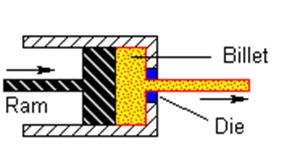
Figure 1: A schematic of the extrusion process.
http://www.matter.org.uk/glossary
The extrusion process for aluminum, or any metal, is fairly simple. Basically a ram pushes a “billet” of material through a die (see Figure 1); the die lets material through in the desired shape. The resulting product is a long piece with the desired cross sectional shape (see Figure 2). The pressures needed here are a bit above Play-Doh; thousands of tones of forces are needed to push aluminum through a die. The biggest extrusion press at Alcoa Lafayette is rivaled by only two others in the world: one in Luybachany, Russia, and another near Atlanta.

Figure 2: An example of shapes that can be made by extrusion. http://www.aluminumextrusions.com/extrusions
DRAWING
Drawing is a process where a tube is pulled through a die with a smaller diameter than the starting tube. Sounds a lot like extrusion, doesn’t it? The only real difference is that you are pulling a long piece through a die instead of pushing a stubby billet. So why not skip drawing and just extrude metal in the diameter you need? The reason is the force required to push something through a die increases as the cross sectional area of the product decreases. There reaches a point where no matter how much force you put on the metal billet, the metal will not extrude through die. To overcome this limitation, a tube of a larger diameter and thickness that is needed is extruded, then drawn down to size later. This adds extra time to the process, but it saves wear and tear on the extrusion presses.
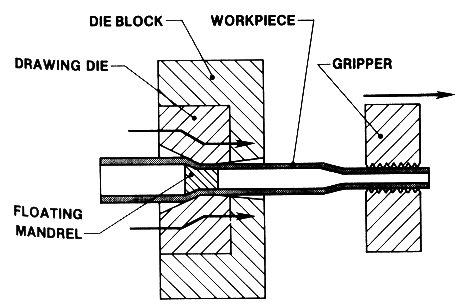

Figure 3 (upper) and Figure 4 (lower): A simplified view of tube drawing: the gripper grips the tube and pulls it through the die and over the mandrel. The mandrel keeps the tube from collapsing on itself while it is being pulled. The result is shown in Figure 4.
http://class.et.byu.edu/mfg130/processes/descriptions/deformation/tubedrawing.htm
HOT METAL!
Heat treatment is a process that gives aluminum both the ability to be formed and at the same time increases its strength. The two most common types of heat-treatment for extrusions are solution treating (or annealing), and aging. A solution treatment softens a metal for further working, while aging hardens it to give it the properties it needs to do its job. So why does a company have to do this? Think of bending a paperclip…..
So as you sit in class one day you start bending a paper clip back and forth. What eventually happens? Of course it breaks, at or near the spot it was being bent. How is it that something that was ductile a moment ago suddenly becomes brittle and breaks? The answer is cold work. As a metal is deformed (i.e. bent, shaped, stamped, extruded), you are performing cold work on it. The more cold work you perform on the material the harder and more brittle the material gets, until it is so brittle it can’t be deformed anymore, and breaks. Extrusion is an extremely deformative process, so the metal is very hard when it comes off the press. Consequently, it is very difficult to form further, as in drawing. A solutioning heat treatment is used to soften the metal so it can be worked further. If several drawing steps are required, the material may have to be annealed several times.
After the material is in its final form (the final diameter, thickness, and length), it is sent to aging. Aging treatments harden the material appreciably, giving it the properties the client specifies. Aging temperatures are lower than solutioning temperatures. The material hardens because of the nucleation and growth of a second phase within the material. This second phase may constitute only 2% of the volume of the metal; however it can increase the strength 200%. Aging times can vary from a few minutes to over a day, depending on the temperature.
Source: https://engineering.purdue.edu/ENE/Research/SGMM/Problems/FactoryLayout/MEA/index_file/FactoryLayout_PreReading.doc
Web site to visit: https://engineering.purdue.edu
Author of the text: indicated on the source document of the above text
Bulk Deformation Processes: Extrusion and Rolling
Bulk Deformation:
There are a number of different manufacturing processes which shape material by using pressure and forces to cause the material to flow into new shapes. When the flow causes major changes in thickness, diameter, length, and other major dimensions this is called bulk deformation.
Bulk deformation processes include:
Rolling--reducing the thickness of a long work-piece using compressive forces applied through a set or multiple sets of rollers
Forging--shaping of discrete work-pieces by use of compressive forces applied to pieces placed in stationary dies.
Extrusion--shaping a solid of constant cross-section by squeezing metal through a die.
Drawing -- shaping a solid of constant cross-section by pulling solid metal through a die.
There are two distinct forms of the extrusion process used:
Hot Extrusion and Cold Extrusion
Hot Extrusion: used to produce long, extended products with a wide variety of constant cross sectional shapes.
-- uses raw material at higher temperatures
-- pressure or force is usually applied horizontally.
-- usually produces parts up to 25 ft long (but in situations can be up to 100 ft)
-- product is then cut into desired lengths and ends are trimmed
-- can produce hollow shapes using special dies or insets
-- cost can be competitive with roll forming
-- moderate to high die and equipment cost
-- low to moderate labor cost
-- low to moderate operator skill
-- commonly used for aluminum, copper, steel, magnesium, and lead.
-- typical products include: railings, tubes, structural shapes, frame materials.
Table 1: Hot Extrusion Temperature Ranges for Various Metals
Metal ºC |
|
Lead |
200-250 |
Aluminum and Aluminum alloys |
375-475 |
Copper and Copper alloys |
650-975 |
Steels |
875-1300 |
Refractory metals |
975-2200 |
Extrusion Process:
A round heated billet (raw material ) is placed in the extrusion chamber and a hydraulic ram is used to force the heated billet through the smaller die opening. As the material is forced through the opening, it takes on the constant cross sectional shape of the opening.
Softer materials such as lead, aluminum, and copper may be extruded without use of lubricants. Harder materials like steel require glass or ceramic lubricants to reduce friction along the sides of the chamber and to reduce the forces on the die.

Parameters used to describe the extrusion process:
Circumscribing Circle Diameter (CCD): smallest diameter circle into which the
extruded cross section will fit.
Shape factor: Ratio of the perimeter of the extruded product to its cross-sectional area.
Extrusion Ratio: ratio of cross sectional area of
billet to that of extruded product, Ao / Af.
Ratios usually range from 10 to 100 (although
can go as low as 4 and as high as 400).
Extrusion force: is estimated from the formula
F = Ao k ln (Ao / Af)
where k is the extrusion constant. Ao and Af are
the billet and extruded product areas respectively.
CCD values for Aluminum: 0.25 inch to 40 inches
Most extrusion manufacturers have a common core of dies for shapes that they readily produce. Many manufacturers also advertise that they will custom make just about any shape you want, but at a higher cost than custom shapes. The shapes shown below are the core offered by one extrusion manufacturer.
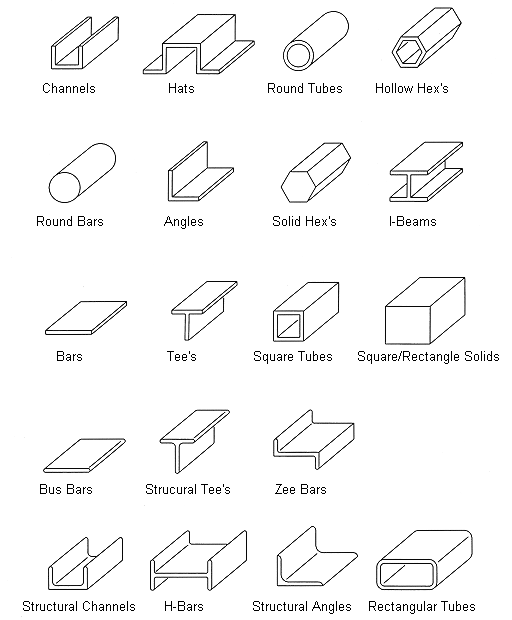
Examples of less standard shapes:
General Design Recommendations:
-- Use standard cross sectional shapes (stock shapes if possible)
-- Limit irregular shapes, sharp corners, and very thin sections.
-- Avoid thin walls sections. They are more difficult to produce and have
limited minimum thickness based on the material used.
Commonly specified minimum wall thicknesses include:
Aluminum 1 mm
Carbon steels 3 mm
Stainless Steel 5 mm
-- Extruded products, especially with small cross sections, require corrective
straightening and twisting which can be compensated for by adding
ridges and ribs to the design.
-- Use as large an internal and external radius as possible to reduce tool
wear, warping, and surface irregularities. Remember sharp corners
produce higher forces, material flow problems, and stress concentration.
-- Softer materials are more forgiving when requiring sharp or irregular features
-- Balance the design (make symmetrical if possible). Symmetrical sections
are preferred over nonsymmetrical sections.
-- Add ribs to act as stiffeners if flatness of a surface is important
-- Avoid extreme changes in the thickness of the section.
-- Holes (especially nonsymmetrical holes) in steels and other lubricated
materials and less easily extruded materials should generally be avoided.
-- Limit the ratio of length to thickness of the cross section.
for steel: L/T < 14:1
for magnesium: L/T < 20:1
Examples:
Poor Extrusion Features Good Extrusion Features


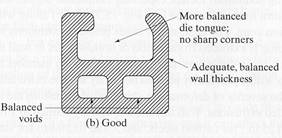

More Extrusion Design Examples:
Poor Better Why?

Cold Extrusion:
Cold or Impact Extrusion is used to produce shorter discrete finished parts where the residue of the billet becomes part of the finished part.
-- uses raw material (billets or slugs) at temperatures usually above room temperature.
-- material undergoes work hardening during the process
-- requires more lubrication
-- used to create a single piece at a time.
-- usually completed with a vertically applied load
-- commonly used for aluminum, copper, lead, tin, magnesium, zinc, and steel.
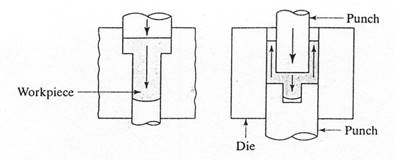
Advantages of Cold Extrusion:
-- improved mechanical properties
-- good control of dimensional tolerances
-- improved surface finishing
-- elimination of heating requirements
-- medium to high initial cost
-- competitive production rates
-- may have a variably shaped cross section
Disadvantages of Cold Extrusion:
-- very high stresses
-- extremely resistant and tough dies and punches required
-- quality, surface finish, and size of slug is important
-- lubrication is even more critical
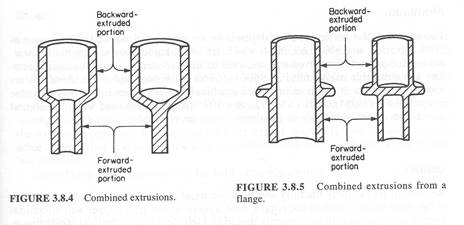

Typical characteristics of a part that might be made by Cold or Impact Extrusion:
-- part length is greater than 2 or 3 times the diameter
-- part is hollow with one end closed or partially closed
-- part would require considerable machining if made another way.
-- the base must be thicker than the sidewalls
-- zero draft is desired in the sidewalls
-- redesign will permit use of a one-piece part instead of an assembly
-- large quantity production is planned.
-- part has symmetry

Design Considerations:
-- make part symmetrical about long axis
-- bottom of part should have greater or equal thickness to side walls
-- bottom should be tapered toward the center.
-- limit height of external ribs to less than 2 times the wall thickness
of internal ribs to less than 3 time the wall thickness
-- use rounded exterior corners; use relatively sharp inside corners
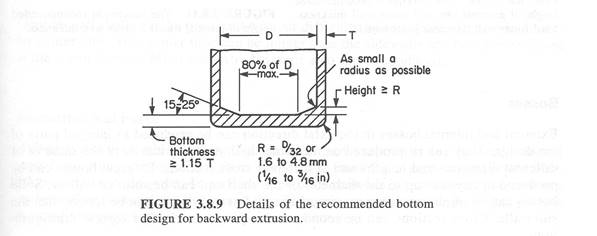
Drawing:
Drawing is a process which pulls metal through a die to reduce or change the cross-sectional shape.
-- used for production of long rod and wire
-- used for round or a variety of cross-sections
-- smaller cross-sections than extrusions
-- lubrication is required
-- good surface finish
-- low to moderate die, equipment, and labor costs
-- low to moderate operator skill required.
-- work hardens the material

Reductions in cross section by drawing range from near 0 to 45% per pass. Thin wires are usually drawn at 15% to 25%... Thicker sizes at 20% to 45%.
Reductions of more than 45% result in lubricants breaking down and poor surface finishes.
Annealing may be necessary between passes due to work hardening of materials.
Drawing Equipment:
Draw bench:
--uses a single die
-- used for drawing straight rods and tubes (up to 100 ft)
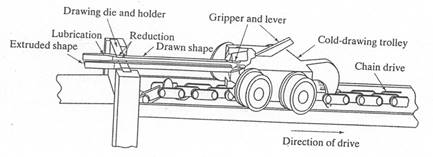
Rotating drums:
-- uses multiple dies
-- used for very long rod and wire and smaller cross sections.
Rolling:
Rolling is the process of reducing the thickness of a long workpiece by compressive force applied through a set of rolls.
--used to produce flat plates, sheets and foil in long lengths, at high speeds and with good
surface finish in process called flat rolling.
plates: rolled materials have a thickness greater than 6 mm and used for
structural applications.
sheets: generally less than 6 mm thick supplied in either flat or coil form.
foil: extremely thin sheets of metal less than 1/100 of a mm thick
-- also used to produce structural shapes such as I-beams, Rails, and Channel in processs
called shape rolling.
-- high capital investment cost
-- low to moderate labor cost
-- moderate operator skill required
Hot Rolling: rolling that occurs at high temperatures.
-- used to break down cast ingot and also used in the continuous casting of metal.
-- produces finer grains and enhanced ductility
-- closes up internal defects and reduces porosity.
Cold Rolling: rolling that is done at room temperature.
-- produce sheets and strips with good surface finish
-- more accurate dimensional tolerances
-- stronger material, due to strain hardening.
Ring Rolling: used to produce a ring of
desired diameter and cross sectional shape.
Thread Rolling: a cold forming process used to make straight or tapered threads on round rods.
-- doesn't produce any metal scrap
-- strain hardens the threads in the process
-- sets up compressive residual surface stresses (resistant to fatigue)
-- produces smooth surface finish
-- better grain structure of threaded parts, than produced by cutting
Seamless Tube Production: produces a seamless thick walled tube using rotatry tube piercing.
-- center-line crack is set up by rotating, radial pressure
-- a mandrel is used to expand the hole and size the inner liner as the slightly skewed roller draw the part forward.
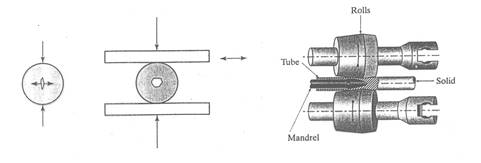
Source: http://www.rose-hulman.edu/Class/me/ME317/Merkel%20Lectures/ME317Lecture05ExtrusionAndRollForming.doc
Web site to visit: http://www.rose-hulman.edu
Author of the text: indicated on the source document of the above text
If you are the author of the text above and you not agree to share your knowledge for teaching, research, scholarship (for fair use as indicated in the United States copyrigh low) please send us an e-mail and we will remove your text quickly. Fair use is a limitation and exception to the exclusive right granted by copyright law to the author of a creative work. In United States copyright law, fair use is a doctrine that permits limited use of copyrighted material without acquiring permission from the rights holders. Examples of fair use include commentary, search engines, criticism, news reporting, research, teaching, library archiving and scholarship. It provides for the legal, unlicensed citation or incorporation of copyrighted material in another author's work under a four-factor balancing test. (source: http://en.wikipedia.org/wiki/Fair_use)
The information of medicine and health contained in the site are of a general nature and purpose which is purely informative and for this reason may not replace in any case, the council of a doctor or a qualified entity legally to the profession.
The texts are the property of their respective authors and we thank them for giving us the opportunity to share for free to students, teachers and users of the Web their texts will used only for illustrative educational and scientific purposes only.
All the information in our site are given for nonprofit educational purposes